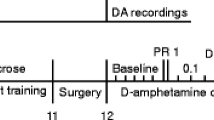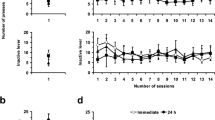Abstract
Rationale
Alcohol use in adolescence is one of the most significant predictors of alcohol dependence in adulthood, yet the neurochemical mechanisms underlying this heightened vulnerability remain unknown. Whereas research has focused on characterizing adaptations in the mesolimbic dopamine (DA) system following ethanol exposure in adolescence, whether these changes persist into adulthood has yet to be determined.
Objectives
The objective of this study is to investigate the effects of binge-intermittent ethanol administration in adolescence (P30–50) or early adulthood (P60–80) on DA in the nucleus accumbens (NAc) core after an ethanol challenge in adulthood following a period of abstinence.
Methods
Male Sprague Dawley rats (n = 160) were administered intermittent ethanol injections, 1 or 3 g/kg, intraperitoneally (i.p.) every other day for 20 days starting on either P30 or 60. Following an ethanol-free period of either 7, 14, or 28 days, we measured DA efflux following an ethanol challenge (3 g/kg, i.p.) using electrochemical recording electrodes bilaterally implanted into the NAc core.
Results
Moderate-dose ethanol administration (1 g/kg, i.p.) during adolescence significantly decreased ethanol-evoked DA release in adulthood at 7 and 14 days, but not 28 days, following pretreatment exposure compared to saline controls. Relative to rats pretreated with ethanol in adulthood, moderate-dose ethanol in adolescence significantly reduced DA efflux at all time points measured. Additionally, adult rats pretreated with high dose ethanol administration (3 g/kg, i.p.) displayed significantly decreased DA compared to adolescents after 28 days of withdrawal.
Conclusions
Binge-intermittent ethanol administration during adolescence may induce age-dependent neuroadaptations in the mesolimbic DA system compared to ethanol-treated adults during protracted ethanol withdrawal.




Similar content being viewed by others
References
Alaux-Cantin S, Warnault V, Legastelois R, Botia B, Pierrefiche O, Vilpoux C, Naassila M (2013) Alcohol intoxications during adolescence increase motivation for alcohol in adult rats and induce neuroadaptations in the nucleus accumbens. Neuropharmacology 67:521–531
Badanich KA, Adler KJ, Kirstein CL (2006) Adolescents differ from adults in cocaine conditioned place preference and cocaine-induced dopamine in the nucleus accumbens septi. Eur J Pharmacol 550:95–106
Badanich KA, Maldonado AM, Kirstein CL (2007) Chronic ethanol exposure during adolescence increases basal dopamine in the nucleus accumbens septi during adulthood. Alcohol Clin Exp Res 31:895–900
Blaha CD (1996) Evaluation of stearate-graphite paste electrodes for chronic measurement of extracellular dopamine concentrations in the mammalian brain. Pharmacol Biochem Behav 55:351–364
Blaha CD, Phillips AG (1990) Application of in vivo electrochemistry to the measurement of changes in dopamine release during intracranial self-stimulation. J Neurosci Methods 34:125–133
Blaha CD, Phillips AG (1996) A critical assessment of electrochemical procedures applied to the measurement of dopamine and its metabolites during drug-induced and species-typical behaviours. Behav Pharmacol 7:675–708
Blaha CD, Liu D, Phillips AG (1996) Improved electrochemical properties of stearate-graphite paste electrodes after albumin and phospholipid treatments. Biosens Bioelectron 11:63–79
Boileau I, Assaad JM, Pihl RO, Benkelfat C, Leyton M, Diksic M, Tremblay RE, Dagher A (2003) Alcohol promotes dopamine release in the human nucleus accumbens. Synapse 49:226–231
Brodie MS, Shefner SA, Dunwiddie TV (1990) Ethanol increases the firing rate of dopamine neurons of the rat ventral tegmental area in vitro. Brain Res 508:65–69
Budygin EA, Phillips PEM, Robinson DL, Kennedy AP, Gainetdinov RR, Wightman RM (2001) Effect of acute ethanol on striatal dopamine neurotransmission in ambulatory rats. J Pharmacol Exp Ther 297:27–34
Budygin EA, Oleson EB, Mathews TA, Lack AK, Diaz MR, McCool BA, Jones SR (2007) Effects of chronic alcohol exposure on dopamine uptake in rat nucleus accumbens and caudate putamen. Psychopharmacology (Berl) 193:495–501
Carroll MR, Rodd ZA, Murphy JM, Simon JR (2006) Chronic ethanol consumption increases dopamine uptake in the nucleus accumbens of high alcohol drinking rats. Alcohol 40:103–109
DeWit DJ, Adlaf EM, Offord DR, Ogborne AC (2000) Age at first alcohol use: a risk factor for the development of alcohol disorders. Am J Psychiatry 157:745–750
Dickson P, Rogers T, Lester D, Miller M, Matta S, Chesler E, Goldowitz D, Blaha C, Mittleman G (2011) Genotype-dependent effects of adolescent nicotine exposure on dopamine functional dynamics in the nucleus accumbens shell in male and female mice: a potential mechanism underlying the gateway effect of nicotine. Psychopharmacology (Berl) 215:631–642
Frantz KJ, O'Dell LE, Parsons LH (2007) Behavioral and neurochemical responses to cocaine in periadolescent and adult rats. Neuropsychopharmacology 32:625–637
Gessa GL, Muntoni F, Collu M, Varqui L, Mereu G (1985) Low doses of ethanol activate dopaminergic neurons in the ventral tegmental area. Brain Res 348:201–203
Grant BF, Dawson DA (1997) Age at onset of alcohol use and its association with DSM-IV alcohol abuse and dependence: results from the national longitudinal alcohol epidemiologic survey. J Subst Abus 9:103–110
Guerri C, Pascual M (2010) Mechanisms involved in the neurotoxic, cognitive, and neurobehavioral effects of alcohol consumption during adolescence. Alcohol 44:15–26
Imperato A, Di Chiara G (1986) Preferential stimulation of dopamine release in the nucleus accumbens of freely moving rats by ethanol. J Pharmacol Exp Ther 239:219–228
Koob GF, Bloom FE (1988) Cellular and molecular mechanisms of drug dependence. Science 242:715–723
McCutcheon JE, Marinelli M (2009) Age matters. Eur J Neurosci 29:997–1014
McCutcheon JE, Conrad KL, Carr SB, Ford KA, McGehee DS, Marinelli M (2012) Dopamine neurons in the ventral tegmental area fire faster in adolescent rats than in adults. J Neurophysiol 108:1620–1630
Nasrallah NA, Clark JJ, Collins AL, Akers CA, Phillips PE, Bernstein IL (2011) Risk preference following adolescent alcohol use is associated with corrupted encoding of costs but not rewards by mesolimbic dopamine. Proc Natl Acad Sci U S A 108:5466–5471
Natividad L, Tejeda H, Torres O, O'Dell L (2010) Nicotine withdrawal produces a decrease in extracellular levels of dopamine in the nucleus accumbens that is lower in adolescent versus adult male rats. Synapse 64:136–145
Natividad LA, Buczynski MW, Parsons LH, Torres OV, O'Dell LE (2012) Adolescent rats are resistant to adaptations in excitatory and inhibitory mechanisms that modulate mesolimbic dopamine during nicotine withdrawal. J Neurochem 123:578–588
Odell WD (1990) Sexual maturation in the rat. In: Grumbach MM, Sizonenko PC, Aubert ML (eds) Control of the onset of puberty. Lippincott Williams & Williams, Baltimore, pp 183–210
Palm S, Nylander I (2014) Dopamine release dynamics change during adolescence and after voluntary alcohol intake. PLoS One 9:e96337
Pascual M, Boix J, Felipo V, Guerri C (2009) Repeated alcohol administration during adolescence causes changes in the mesolimbic dopaminergic and glutamatergic systems and promotes alcohol intake in the adult rat. J Neurochem 108:920–931
Paxinos G, Watson C (1997) The rat brain in stereotaxic coordinates. Academic, San Diego
Philpot RM, Wecker L, Kirstein CL (2009) Repeated ethanol exposure during adolescence alters the developmental trajectory of dopaminergic output from the nucleus accumbens septi. Int J Dev Neurosci 27:805–815
Sabeti J, Gerhardt GA, Zahniser NR (2003) Chloral hydrate and ethanol, but not urethane, alter the clearance of exogenous dopamine recorded by chronoamperometry in striatum of unrestrained rats. Neurosci Lett 343:9–12
Sahr AE, Thielen RJ, Lumeng L, Li TK, McBride WJ (2004) Long-lasting alterations of the mesolimbic dopamine system after periadolescent ethanol drinking by alcohol-preferring rats. Alcohol Clin Exp Res 28:702–711
SAMHSA (2012) Results from the 2011 National Survey on Drug Use and Health: summary of national findings NSDUH Series H-44. Substance Abuse and Mental Health Services Administration, Rockville
Silvers JM, Tokunaga S, Mittleman G, Matthews DB (2003) Chronic intermittent injections of high-dose ethanol during adolescence produce metabolic, hypnotic, and cognitive tolerance in rats. Alcohol Clin Exp Res 27:1606–1612
Silvers JM, Tokunaga S, Mittleman G, O'Buckley T, Morrow AL, Matthews DB (2006) Chronic intermittent ethanol exposure during adolescence reduces the effect of ethanol challenge on hippocampal allopregnanolone levels and Morris water maze task performance. Alcohol 39:151–158
Spear LP, Varlinskaya EI (2010) Sensitivity to ethanol and other hedonic stimuli in an animal model of adolescence: implications for prevention science? Dev Psychobiol 52:236–243
Stamford JA (1989) Development and ageing of the rat nigrostriatal dopamine system studied with fast cyclic voltammetry. J Neurochem 52:1582–1589
Tokunaga S, Silvers JM, Matthews DB (2006) Chronic intermittent ethanol exposure during adolescence blocks ethanol-induced inhibition of spontaneously active hippocampal pyramidal neurons. Alcohol Clin Exp Res 30:1–6
Ungless MA, Argilli E, Bonci A (2010) Effects of stress and aversion on dopamine neurons: implications for addiction. Neurosci Biobehav Rev 35:151–156
Weiss F, Lorang MT, Bloom FE, Koob GF (1993) Oral alcohol self-administration stimulates dopamine release in the rat nucleus accumbens: genetic and motivational determinants. J Pharmacol Exp Ther 267:250–258
Wise RA (1996) Addictive drugs and brain stimulation reward. Annu Rev Neurosci 19:319–340
Yavich L, Tiihonen J (2000) Ethanol modulates evoked dopamine release in mouse nucleus accumbens: dependence on social stress and dose. Eur J Pharmacol 401:365–373
Acknowledgments
Funding supported by NIAAA, 1U01AA13509 to D.B.M., and 1U01AA13506 to G.M.
Conflict of interest
The authors declare no competing financial interests.
Author information
Authors and Affiliations
Corresponding author
Additional information
Shannon L. Zandy, Douglas B. Matthews, and Anthony Miller contributed equally.
Rights and permissions
About this article
Cite this article
Zandy, S.L., Matthews, D.B., Tokunaga, S. et al. Reduced dopamine release in the nucleus accumbens core of adult rats following adolescent binge alcohol exposure: age and dose-dependent analysis. Psychopharmacology 232, 777–784 (2015). https://doi.org/10.1007/s00213-014-3712-1
Received:
Accepted:
Published:
Issue Date:
DOI: https://doi.org/10.1007/s00213-014-3712-1




